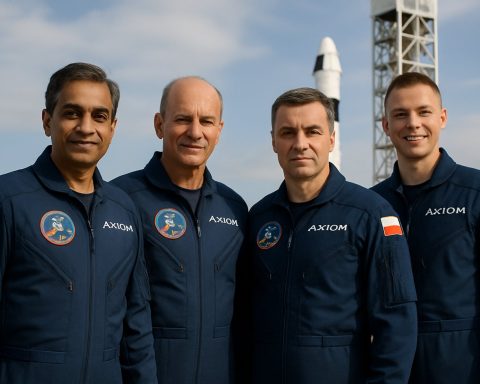- K2-18b, an exoplanet in the constellation Leo, lies over 120 light-years away and belongs to the Hycean category, potentially hosting oceans beneath hydrogen-rich atmospheres.
- The James Webb Space Telescope has detected methane and carbon dioxide in K2-18b’s atmosphere, hinting at potential biological processes.
- K2-18b is located in the “habitable zone” of its star, allowing for conditions that could sustain liquid water — crucial for life as we know it.
- Despite being a “sub-Neptune,” its atmospheric composition suggests it may differ significantly from rocky planets like Earth.
- Advanced infrared observations from the James Webb Telescope have provided insights into K2-18b’s atmospheric composition, fueling anticipation of possible biosignatures.
- The relentless pursuit of finding life beyond Earth extends to Mars, Europa, and other celestial bodies.
- Humanity’s quest for extraterrestrial life continues unabated, driven by the hope of profound discoveries in the cosmos.
The boundless stretches of space hold mysteries that continue to captivate the human imagination, and now a new cosmic puzzle has emerged. In the constellation Leo, more than 120 light-years away, a far-off exoplanet named K2-18b is stirring excitement among astronomers. This planetary enigma is part of a group of celestial bodies known as Hycean planets, which are distinguished by their potential to host vast oceans beneath hydrogen-rich atmospheres.
The James Webb Space Telescope, NASA’s state-of-the-art cosmic eye, has recently unveiled tantalizing signs that this distant world could be more than just a barren rock. Observations captured methane and carbon dioxide in its atmosphere — elements that, on Earth, often suggest the presence of life. This has ignited speculation and curiosity, as these molecules are typically indicative of biological processes, possibly hinting at microbial life forms thriving in alien conditions.
K2-18b resides comfortably within the “habitable zone” of its host star, where temperatures could allow liquid water to exist—a crucial factor for life as we know it. This orbit places it in the exclusive class of “Goldilocks” planets, where conditions are neither too hot nor too cold. However, unlike the more familiar rocky worlds, K2-18b is a “sub-Neptune,” suggesting its makeup is quite different from terrestrial planets.
The James Webb’s advanced infrared capabilities have opened a new chapter in our interstellar curiosity, revealing atmospheric complexities that prior telescopes could not decipher. As the planet passes in front of its star from Earth’s perspective, starlight filters through its atmosphere—leaving a spectral fingerprint that astronomers can analyze to infer the composition of alien skies. Scientists eagerly anticipate additional observations that may confirm the presence of aromatic biosignatures which, if verified, could revolutionize our understanding of life’s potential in the universe.
Beyond K2-18b, other corners of our solar system are under scrutiny in the relentless search for life. The barren landscapes of Mars and the frosty surface of Jupiter’s moon Europa are also prime targets for exploration, with hopes of uncovering bygone or extant alien life. As robotic scouts roam these nearby worlds, telescopes like the James Webb offer a grander vista, peering into the distant cosmos for the faintest hints of life beyond Earth.
While evidence of intelligent extraterrestrial civilizations remains elusive, the thrill of discovery persists as a profound reminder of our desire to understand our place in the universe. With thousands of UFO sightings reported and the continuous work of organizations like the Search for Extraterrestrial Intelligence, humanity remains steadfast in its pursuit of the unknown.
Whether the whispers from K2-18b will grow into the roar of a monumental discovery or remain an astrophysical enigma, one thing is clear: we are on the precipice of new beginnings in the vast theater of the cosmos. Stay tuned for what promises to be an exhilarating journey into the universe’s most profound secrets.
Is K2-18b the Key to Unlocking Extraterrestrial Life?
Exploring the Mysteries of K2-18b
K2-18b, an exoplanet located over 120 light-years away in the constellation Leo, has become an exciting enigma for astronomers across the globe. Recently, the James Webb Space Telescope (JWST) has captured intriguing data suggesting this distant world, a Hycean planet, may have the conditions suitable for life. Here’s an in-depth look into what makes K2-18b so fascinating and the implications for extraterrestrial life.
What is a Hycean Planet?
Hycean planets are a new classification of exoplanets characterized by vast, deep oceans underneath hydrogen-rich atmospheres. Unlike Earth-like planets, their atmospheres and potential for hosting life make them a prime focus for researchers. K2-18b fits this category perfectly, potentially teeming with biological processes or life forms.
How the James Webb Space Telescope Revolutionizes Space Exploration
The James Webb Space Telescope’s advanced infrared capabilities have provided unprecedented insights into K2-18b’s atmospheric composition, revealing molecules such as methane and carbon dioxide. These molecules are typically indicative of biological activity on Earth. By analyzing starlight filtered through K2-18b’s atmosphere, astronomers gain valuable information about the planet’s potential to harbor life.
Real-World Use Cases and Implications
1. Astrobiology Research: Discoveries on K2-18b could guide strategies for identifying life on other planets, enhancing understanding of how life could form in varied atmospheres.
2. Astronomy and Space Technology: Utilizing instruments like JWST lays the groundwork for improved technologies in interpreting signals from distant celestial bodies.
3. Education and Public Engagement: Astonishing revelations about K2-18b could invigorate interest in science, technology, engineering, and mathematics (STEM) fields.
Possible Controversies and Limitations
– False Positives: Methane and carbon dioxide are not exclusive to biological processes, and alternative explanations, such as volcanic activity, must be thoroughly evaluated.
– Technological Challenges: The vast distances and technical limitations mean it may be decades before conclusive evidence of life is found.
Market Trends and Future Exploration
Interest in space exploration is rapidly increasing, with public and private sectors investing in new technologies. Market analysts predict continued growth in the space exploration sector as advancements like the JWST inspire further investment in astronomical research and space travel initiatives.
Insights and Predictions
The coming years could witness groundbreaking discoveries regarding extraterrestrial life, changing humanity’s understanding and place in the cosmos. Investigations will likely broaden to include other potentially habitable regions, such as the moons Europa and Enceladus, where liquid water may exist beneath icy crusts.
Quick Tips for Aspiring Astronomers
– Stay Informed: Follow reputable channels and journals like Nature and NASA updates to keep abreast of the latest discoveries and technologies.
– Develop Skills: Cultivate expertise in data analysis, critical thinking, and scientific methodology—crucial for careers in astronomy.
– Engage in Community: Join local astronomy clubs or online forums to connect with like-minded individuals passionate about the universe.
Conclusion
While K2-18b presents many unanswered questions, continued research could unlock profound secrets about life in the universe. Whether it proves to host life forms or remains an astrophysical curiosity, the quest to explore such planets provides invaluable insights and inspires humanity’s endless fascination with the cosmos.
For further reading on cutting-edge astronomy and space exploration, check out NASA’s homepage: NASA.







